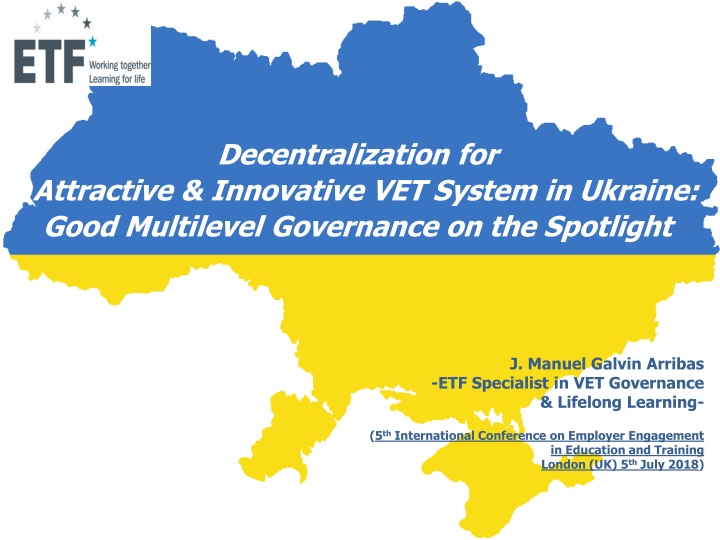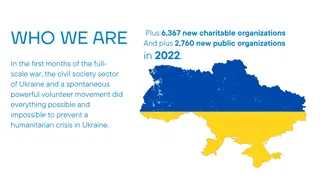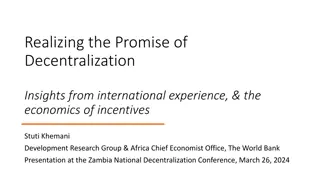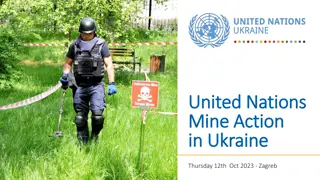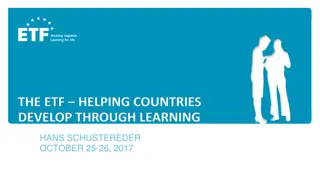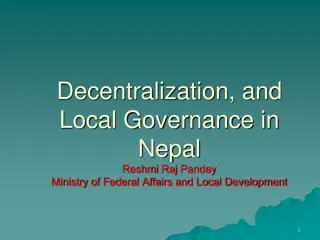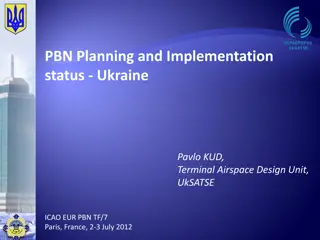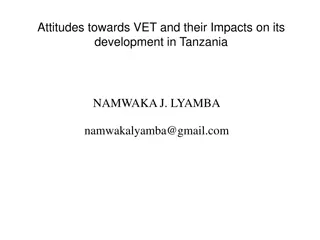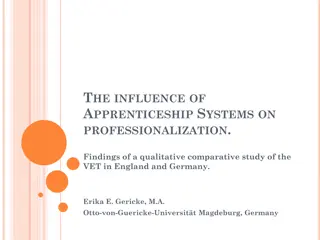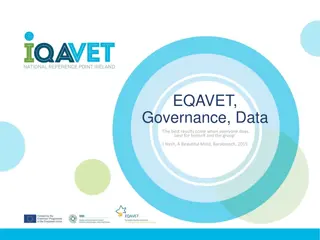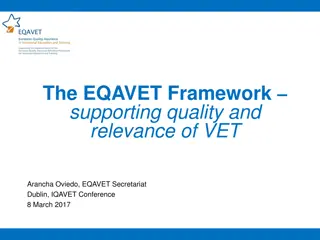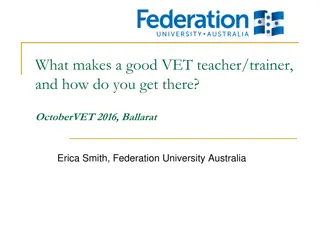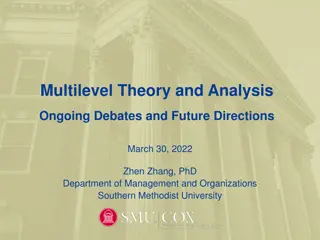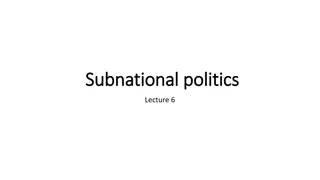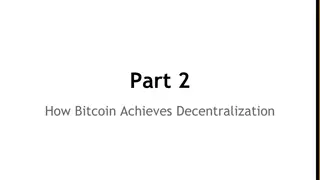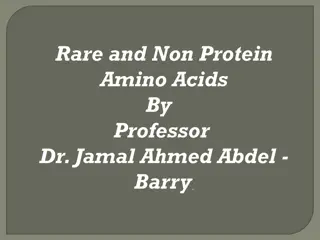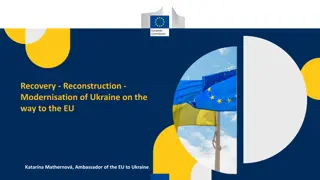Decentralization for an Innovative VET System in Ukraine: Multilevel Governance Spotlight
At the 5th International Conference on Employer Engagement in Education and Training, J. Manuel Galvin Arribas discusses the attractive and innovative VET system in Ukraine, highlighting the importance of decentralization and multilevel governance. The ETF supports VET reforms within a lifelong learning perspective in various EU neighborhood regions and countries such as Kazakhstan, Kyrgyzstan, and Serbia. Key socio-demographic, economic, and education indicators from 2011 to 2016 reveal challenges and opportunities in Ukraine's GDP, educational attainment, and employment landscape amid ongoing political, administrative, and social challenges.
Download Presentation

Please find below an Image/Link to download the presentation.
The content on the website is provided AS IS for your information and personal use only. It may not be sold, licensed, or shared on other websites without obtaining consent from the author.If you encounter any issues during the download, it is possible that the publisher has removed the file from their server.
You are allowed to download the files provided on this website for personal or commercial use, subject to the condition that they are used lawfully. All files are the property of their respective owners.
The content on the website is provided AS IS for your information and personal use only. It may not be sold, licensed, or shared on other websites without obtaining consent from the author.
E N D
Presentation Transcript
Decentralization for Attractive & Innovative VET System in Ukraine: Good Multilevel Governance on the Spotlight J. Manuel Galvin Arribas -ETF Specialist in VET Governance & Lifelong Learning- (5th International Conference on Employer Engagement in Education and Training London (UK) 5th July 2018)
The ETF: Supporting reforms in VET within LLL perspective & Labour Markets in (4) EU Neighborhood regions Other countries from Central Asia: Kazakhstan, Candidate countries: Kyrgyzstan, Tajikistan, Turkmenistan, Uzbekistan Rep. of Macedonia, Turkey , Serbia Potential candidate countries: Albania, Bosnia and Herzegovina, Kosovo ,Montenegro . EU Partnership East: Armenia, Azerbaijan, Belarus, Georgia, Republic of Moldova, Ukraine and Russia Federation. European Neighbourhood and Partnership Instrument countries (SEMED) ENP South: Algeria, Egypt, Jordan, Lebanon, Morocco, Occupied Palestinian Territory, Tunisia, Israel, Libia-(Syria suspended). 2
Ukraine (2011-2016): Key Socio Demographic, Economic & Education indicators Ukraine: Key Socio Demographic, Economic & Education Indicators (2011-2016) 2011 2016 Total Population 45598.2 42590.9 Relative size of youth population (15-24)(%) 18.2 14.6 Youth Dependency ratio (%) 20.2 21.9 Old Dependency ratio (%) 22.6 22.5 24.1 (2014) 24.6 Gini Index (%) Gross Enrolement rates Secondary Education(%) 99.2(2014) 93.2 Share of VET students Secondary Education(%) 8.1 (2015) 8.8 Gross enrolement rates Upper Secondary Education(%) Share of VET students Upper Secondary Education(%) 92.6 (2014) 81.8 29.4 (2015) Rank 85 Score 4 31.3 Rank 82 Score 4 Global Competitive Index (Rank & Score) Summing up (2011-2016) : Population shrinking & young population (only 14.6%). Ageing society (among top of 30 oldest countries in the world) : more than 1/5 dependents to the working age population. Universal access to General Education whilst access to Vocational Education and Training (VET) is declining. Competitiveness remains stagnated.
Ukraine (2011-2016): GDP, Educational Attainment, Employment & Unemployment at a glance Summing up (2011-2016) : Spite economy grew in 2016 (2,3%), GDP (per capita) decreased with continuous decline of GDP growth rate (with regional imbalances) in this period. The 98 % adult population holds medium-high qualifications. Services dominant sector + high share of informal economy. Youth unemployment (32% -biggest for males 24%-). All levels of qualification are hit by economic deterioration (mediums bit more).
On-going additional (geo) political, administrative & social challenges & milestones shaping Ukrainian context CHALLENGES The conflict in Eastern Ukraine (from 2014): many citizens forced to flee their houses are becoming vulnerable citizens. The UA-RF conflict might continue escalating. Well being and life expectancy at birth (+/- 70 years) remaining low. Anti-Corruption reforms, Independent media & Civil Society status major issues at stake. Nowadays, national governance is strongly influenced by 2019 Parliamentary elections. MILESTONES The EU-Ukraine Association Agreement (2014) fully came into force (Sept. 2017). The Visa-Free Regime with EU is a reality ( June 2017). Decentralization reform is on its way: 700 amalgamated gromadas (comprising 3.300 villages and towns). Political will. As a result of fiscal decentralization, communities are enjoying closer better services from local self-governments: improved local democratic governance.
The decentralization of Ukrainian VET system: momentum for activating structural reforms. Between 2000- 2015, number of professional-technical schools decreased by 18%, and the number of institutions of I/II accreditation level decreased by 44%. Between 2000- 2015, number of students in institutions of I/II accreditation levels declined by 56% and students of professional and technical schools by 42%
VET Decentralization in Ukraine : Drivers for reforming VET unlocking Governance & Financing (Policy issues vs. Policy options) -ETF & MoES of Ukraine Green Paper (January 2017): informing (forthcoming) VET law - GOOD MULTILEVEL GOVERNANCE (GMLG) approachfor effective VET Decentralization in Ukraine, including: Optimization and Rationalization of VET school-regional- networks VET School Management, Financing and Autonomy. Public-Private Partnership in Ukrainian VET.
Institutional, Informational and Financial aspects of VET Good Multilevel Governance (GMLG) in Ukraine KEY OPTIONS BROAD ISSUES Inter (& Intra) Ministerial -& Social Partners- Cooperation Platform (3-5 years). Shape -new-VET strategic vision at national & regional/local levels. Analytical Framework for VET decentralization (governance & financing); Review of Institutional Arrangements (RIA). VET Communication & Information Plan. Review system of merits for Academic Stipends towards performance-based criteria. Relieve cities of oblast significance of financial management (except Kiev city) and give it back to strengthened Regional powers, by involving cities on sectoral coordination and planning. Replace Regional order by labour market prognosis-based mechanisms (in VET law). Adjust Budget code & reintroduce VET subvention. Reform formula funding mechanisms and legislate tax policies for funding VET. Implement NQF fully aligned to VET decentralization process. Empower Regional VET Councils vested with analytical, advisory & managerial capacities. Set up Executive/supervisory agency (e.g. APEX body) to monitor and oversight VET decentralized-system. Institutionalize skills matching function (e.g. Regional Observatories). The effective distribution of roles/functions/responsibilities across different levels is not clear: VET decentralization model is not shaped. Communication & Partnership for improve VET status. The strong social role of VET hampers VET to serve for Socioeconomic and Regional Development. The Governance of VET financing: what model for VET decentralization. VET & the Lifelong Learning logic. Institutional development for effective Regional VET Governance. The underdeveloped- anticipatory function of VET GMLG.
VET GMLG: Optimization and rationalization of Ukrainian VET school-regional- networks KEY OPTIONS BROAD ISSUES The unit of analysis for VET decentralization should be the REGIONAL VET NETWORK. Optimization pre-condition: finalize plans for upper-secondary education reform. Assigning VET buildings to other educational institutions (e.g. secondary education ,o pre-school education system reforms). Assigning VET buildings to other state public functions (discuss in Verkhovna Rada ). Sale VET school facilities to private companies (use revenues for VET funding and private actors engagement). Amalgamating by affiliating VET schools of different areas by grouping clusters (transition plan). Deliver National & Regional Guidelines and involve VET Regional Councils in decision- making. Launch a project on quality and efficiency of VET providers: measuring performance. Implement management by principle approach: VET performance culture (e.g. VET outcome indicators). Explore VET Centres of Excellence concept to connect public/private & regional socioeconomic interests. Improve dialogue among H.E & VET communities profiting NQFs working groups. The VET School Network in Ukraine (PTUs + I & II accreditation levels) is not fully effective and rather unsustainable. The decision on transfer of VET school property ownership is hampering and postponing any attempt of reforming VET network . Criteria-setting for closing, merging or creating new- VET schools is lagging behind. The decline VET students population in schools will continue in the near future. The rights, roles, rules and operations of founders of VET institutions need further work in (draft) VET law (art.13.1 & 17).
VET GMLG: VET school operations dilemmas in decentralized context in Ukraine KEY OPTIONS BROAD ISSUES Increase regional component of VET school networks delegating more managerial competences to regional powers (Education Departments/Regional Councils). Modernise mechanism for selection of school directors & empowering role of regional commissions. Re-visit role of VET school directors whilst enhancing accountability mechanisms in their interaction with different councils /committees . Replace staffing schedule for more flexible mechanism to facilitate action of Directors managing human resources of VET schools. Launch general continuing training plan for VET teachers community to fill gaps on shortage of Masters and on quality of VET provision. Clarify and limit social function of VET schools to alleviate director responsibilities on minority/disadvantages student groups. Give more autonomy to VET schools on budget allocation for purchasing, encourage income generating activities and grant them for VET innovation in curricula. Discuss options on students enrolments for financing VET schools (e.g. VET schools competing for students, or for assigned groups or enrolments number set by the founder, etc.). VET School Autonomy is an ambition but current state of art of VET system hampers to balance financial, managerial and/or curricula development tasks for VET schools. The leadership of VET Directors and the role of VET schools boards is matter of conflict in many cases to exercise operational power. The VET schools have several procedural and legal problems for hiring teachers. The transfer of budget to cities for financing VET schools created an alarming situation of lack of funds.
VET GMLG: Public & Private Partnership for Ukrainian VET BROAD ISSUES KEY OPTIONS PPPs sponsorships, centres known about its results/impact. in Ukraine take form training little of Evaluate a sample of practices of PPPs in Ukrainian VET. This should including review effectiveness of current councils system. Use lessons learned to shape a renewed national and regional approach. practical internships: and is The long tradition of councils culture in the country activate a big array of different councils participating in the system. Open platform for Social Dialogue in VET within LLL perspective with task to deliver a National Framework for PPPs in VET which might be replicated at Regional and Sectoral levels. The financial crisis on the VET sector call for urgent increased participation of private actors in VET. Delegate to Regional Councils with involvement of social partners and sector skills councils responsibility for structuring PPPs strategic frameworks in the regions. MLG is about to enhance public & private participation but in Ukraine VET is overall state/public-driven. Replicate experiences of Practical Training Centres' & open policy dialogue for exploring setting up Centres of VET Excellence. Deliver guidelines for governance and financing of apprenticeship system including use of taxation to incentivize employers and further regulate in law. This should open room for dualization of Ukrainian VET. In many cases, employers in Ukraine are not satisfied with VET skill provision. economy Significant share of informal
Lessons learned on VET GMLG & Decentralization in Ukraine: what predictable way forward ? (2018-2020) A needed new Ukrainian VET national concept & strategic framework involving Ukrainian Regions. After new Education Law (Dec. 2017): new VET law as key pillar to modernize role of decentralized VET for supporting socioeconomic & regional development of Ukraine. Efficient model of decentralized VET Regional- Governance & Financing. Deepening on DELEGATION form, balancing VET policy decentralization at Regional level & VET systemic change by increasing VET School Autonomy: Empowering institutional role (& capacities) of Regional VET Councils. Setting up VET Centres of Industrial Excellence/Innovation asnetwork optimization option. VET Public Private Partnership: financial & non-financial incentives much needed for employers engagement to integrate VET learning outcomes into (regionals) Labour Market. Other key policy making pieces: VET Quality Assurance (Q.A) & NQF (National Agency of Qualifications); Multichannel Financing; Career Guidance; Competence-Based Education/Occupational Standards; VET Teachers policy (etc.). ETF & UA MoES joint work resulted on relevant strategic outcomes: forthcoming EU (& MSs Estonia, Germany, Poland, Finland) budget & expertise support.
QUESTIONSPLEASE? ACTORS IN VET MULTILEVEL GOVERNANCE VERTICAL DIMENSION NATIONAL LEVEL (Governments-Ministers, Parliaments, Inter- ministerial bodies-National executive and professional Agencies ) REGIONAL & PRIVATE SECTOR PUBLIC SECTOR LOCAL ACTORS (Regional and local authorities, /executive agencies, deconcentrated structures of national bodies). SCHOOLS COMPANIES TRAINING AGENCIES HORIZONTAL DIMENSION (Social Partners, NGO s, Associations) THANK YOU VERY MUCH !!! jmg@etf.europa.eu
